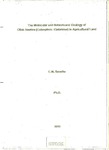The Molecular and behavioural ecology of click beetles (Coleoptera: Elateridae) in agricultural land
| dc.contributor.supervisor | Blackshaw, Rod | |
| dc.contributor.author | Benefer, Carly Marie | |
| dc.contributor.other | Faculty of Science and Engineering | en_US |
| dc.date.accessioned | 2011-06-22T10:53:38Z | |
| dc.date.available | 2011-06-22T10:53:38Z | |
| dc.date.issued | 2011 | |
| dc.date.issued | 2011 | |
| dc.identifier | 10018710 | en_US |
| dc.identifier.uri | http://hdl.handle.net/10026.1/485 | |
| dc.description.abstract |
The larvae (wireworms) of some click beetle genera inhabit the soil in agricultural land and are crop pests. In the UK, a pest complex of Agriotes species, A. obscurus, A. sputator and A. lineatus, has been identified as the cause of the majority of damage. However, studies on their ecology are lacking, despite knowledge of this being important for the development of sustainable risk assessment and pest management strategies, in part due to the morphologically cryptic nature of wireworms. The ecology of economically important click beetle species was investigated, focusing on UK Agriotes species. The relationship between sex pheromone trapped male Agriotes adults and wireworms, identified using a molecular tool (T‐RFLP), was influenced by sampling method, and some environmental variables significantly correlated with species distributions. Scale of sampling influenced the observed distribution of wireworms and other soil insect larvae. Other wireworm species were trapped together with Agriotes species, but mitochondrial 16S rRNA sequences could not be matched to those of other UK species. Sequences from Canadian wireworm samples revealed possible cryptic species. Differences in adult movement rates were found in laboratory tests (A. lineatus > A. obscurus > A. sputator). Molecular markers (AFLPs) were developed to assess dispersal in adult male Agriotes but further protocol optimisation is required. The results show the importance of identifying wireworms to species for assessing adult and wireworm distributions, since the Agriotes pest complex may not be present or as 3 widespread as previously assumed. Sex pheromone trapping of adults may not be appropriate for risk assessment as the relationship between aboveground adult and belowground wireworm species distribution is not straightforward. The differences observed in Agriotes species’ ecology have implications for the implementation of pest management strategies. The techniques used here can be applied in future studies to provide information on other economically important click beetle species worldwide. | en_US |
| dc.language.iso | en | en_US |
| dc.publisher | University of Plymouth | en_US |
| dc.subject | Spatial distribution | |
| dc.subject | Species Identification | |
| dc.subject | Dispersal | |
| dc.subject | Click beetles | |
| dc.subject | Crop pest | en_US |
| dc.title | The Molecular and behavioural ecology of click beetles (Coleoptera: Elateridae) in agricultural land | en_US |
| dc.type | Thesis | |
| dc.identifier.doi | http://dx.doi.org/10.24382/4848 |
Files in this item
This item appears in the following Collection(s)
-
01 Research Theses Main Collection
Research Theses Main


